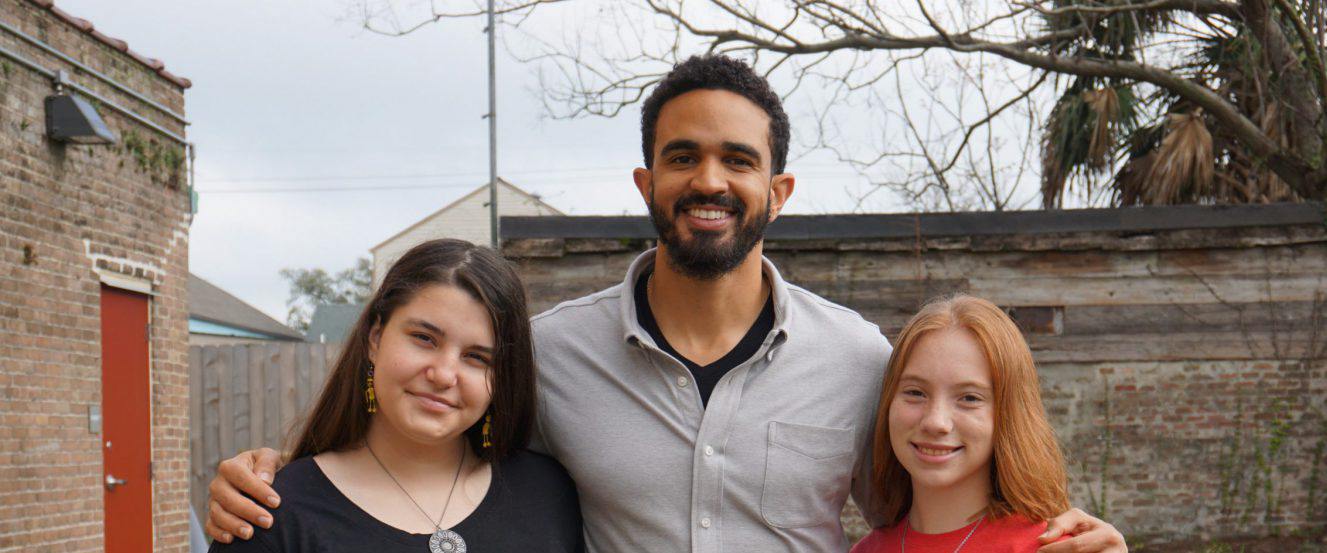Students Use Research and Creativity to Explore Black History Month
These students explore Black History Month and our shared history through hands-on, student-guided projects. See how.

As we continue to observe and celebrate Black History Month, we’re reflecting on how educators and students at XQ school, New Harmony High, explored our shared history and present through hands-on, student-guided projects. By incorporating research with civic engagement and creativity, they added to this important narrative while expanding their academic skillsets.
New Harmony High, where hands-on student projects are a central and celebrated part of the school curriculum, has been open less than a year and a half but already two student projects have won citywide acclaim.
Last year ninth-graders Kira Tonkin and Sofia Olexia-Daigle won first and second place, respectively, in the New Orleans Public Library’s 2019 Black History Month poster contest for teenagers, with their haunting and colorful depictions of the African-American northern migration. This interdisciplinary project is a great one to highlight for Black History Month or any time of the year.
Paying tribute to a social justice icon
“For me, art is a way to show emotions and cope with the past,” Sofia said. “The past can be heavy on a person, and creating art can help you cope and share your emotions and connect with your community.”
Sofia’s drawing depicts a steely-eyed and determined little girl below the words, “The quotes they say is the history they made.” The girl represents Ruby Bridges or a young Rosa Parks, whose courage inspired Sofia (and millions of others) and helped shape the civil rights movement. The words, which Sofia composed, are an homage to the inspirational quotes of Parks and other social justice icons.
A powerful way to tell a story
Kira’s drawing, in pastel and charcoal, depicts a crow ensnared in chains, symbolizing oppressive Jim Crow laws; a blooming magnolia tree representing the South; and a long trail of people marching across sugar cane fields to the state of Washington, where large numbers of African-American Louisianans relocated during the migration.
For Kira, art has long been a powerful way to convey complex emotions and tell a story.
“I’ve always drawn to get out of myself if I’ve had a bad day or I’m not feeling good,” she said. “Drawing helps me to get it out. … I think a lot of people connect to art that way. Putting it on a page helps you connect to other people.”
Researching the history
Anthony Burrell, Kira’s and Sofia’s teacher at New Harmony, was thrilled but not surprised when they won. He and his students had been working on African-American history and culture for some time.
In studying the African-American migration, Burrell encouraged his students to research the history online, then introduced them to Langston Hughes, especially his poem “The Negro Speaks of Rivers,” and Billie Holliday’s mournful protest song, “Strange Fruit.” Expanding on the river theme, he took the students on a field trip up the Mississippi Delta and talked to them about the cultural significance of rivers — why people settle near them, how they define a place, what they represent.
“(The girls) absorbed everything I talked to them about, and then did research on their own,” he said. “They came up with beautiful pictures that were also pretty poignant. I was really excited for them both to win. And glad to see so many other people appreciate their work.”
Translating academic studies into practical projects
Apart from the poster contest, student projects and exhibitions are a key part of life at New Harmony. All students create hands-on projects inspired by their academic research and then present the work publicly.
The exhibitions give students a chance to translate their academic studies into practical, relevant projects that benefit their community, as well as give them the self-confidence that comes from describing their work to adults.
Recent student exhibitions have included:
- Why animal testing in the cosmetics industry is unnecessary
- The impact of absentee fathers
- The environmental and social repercussions of gun violence
- Useful new ways to recycle
For each presentation, students researched the topic, came up with solutions, created a PowerPoint presentation, made a brochure, and led a question-and-answer session. In the process, they learned skills that are key to success in college and most careers: writing, critical thinking, communication, organization, and public speaking.
The most important lesson
Depending on the project, they also exercise their math, science and civics knowledge; learn the difference between qualitative and quantitative research; and develop an understanding of issues that affect their communities.
But the most important lesson, Burrell said, is self-confidence.
“They learn to engage with adults and speak in front of a diverse audience. This makes them more comfortable sharing their work, better speakers, more confident,” he said. “It challenges them in terms of critical thinking and analysis. And by starting them young, when they’re in 9th grade, they’re only going to get better.”
Burrell’s hope for all of his students is that the exhibitions give them the self-confidence to pursue their interests, explore the world beyond New Orleans, and make a positive change in their communities no matter where they end up.
“I always tell my students, especially those who need a little encouragement: Go and meet people. Don’t be shy. Be confident, because you never know where it’s going to lead you,” he said. “Regardless of what my students want to do, I just want to see them grow. And see how far they can go with it.
When asked how New Harmony’s approach is working so far, Burrell thought for a moment and then answered: “They are blossoming.”
Read more about how students are learning through real-world projects:
- The transformative magic of “doing” learning, instead of “receiving” learning
- Hope, empowerment, and saving the planet at New Harmony High
- How a class of young writers explored climate change through storytelling









